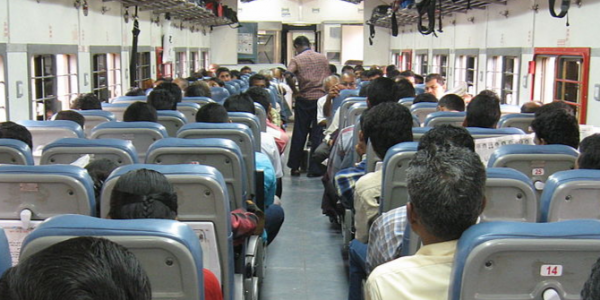 Although High-speed trains have been on the Indian government’s agenda for nearly a decade, there has been little assessment of their impact on domestic airlines, Varun Shridhar writes.
Although High-speed trains have been on the Indian government’s agenda for nearly a decade, there has been little assessment of their impact on domestic airlines, Varun Shridhar writes.
High-speed trains, competition for flights around the world, have been part of the Indian government’s plans at least since the Railway Budget for 2007-08. Yet they find no mention in the National Civil Aviation Policy (NCAP) 2016, formulated years later, perhaps reflecting the lack of political appetite for such plans at the time.
Attitudes have since changed. Two recent events now confirm the political will to modernise the railways in India beyond electronic ticketing. By mid-September, Prime Ministers Narendra Modi and Shinzo Abe laid the foundation stone for the Ahmedabad – Mumbai High Speed Rail (HSR) project, part of the plans from 2007-08. Weeks later, on October 10, India and Germany agreed to study the feasibility of upgrading existing rail infrastructure to run Indian passenger trains at 200 Kilometres per hour (Kph).
If feasible, the upgrade would present game-changing implications for the NCAP 2016 framework and domestic aviation in India as competition has been found to favour faster trains. Academic evidence from Japan, France, China and South Korea suggests a significant decline in air transport demand – sometimes causing an airline to exit from a route altogether – following the entry of a high speed rail between two cities well served by air.
Semi-HSR versus Air Transport
Unlike an HSR or “Bullet Train” that may require dedicated tracks, a semi-HSR can run at speeds up to 200 kph on existing rail infrastructure upgraded for the purpose. Research conducted at the Indian Institute of Management, Ahmedabad, estimates a Kilometre of these upgrades could cost 0.1 billion Indian Rupees – less than a tenth of the 2 billion Rupees per Kilometre cost for dedicated HSR lines.
Despite being easier to finance, however, tracks linking the six or seven major Indian cities are likely to be upgraded first for reasons of catchment, premium yields and viability. Incidentally, domestic air travel demand is highest on ‘trunk routes’ between the same cities. Competition, therefore, could adversely impact airlines at least in the case of the more closely located major urban centres in south India.
The line being studied by the Indo-German collaboration (Chennai to Kazipet, Telangana) may be a case in point. A 100 Kilometre extension of the study and, if feasible, upgrades could achieve a semi-HSR link between Chennai and Hyderabad, two of the South’s largest cities. Even at a lower average speed of say 140 Kph on the 200 Kph line, a semi-HSR service would complete the 750-odd journey in about six hours and match the airport access, egress, check-in and flying times between the cities combined. The fastest conventional passenger trains currently take over twelve hours to complete the same journey.
Competition and outcomes may not be very different elsewhere in the south where major cities lie 6-7 hours apart at semi-HSR speeds. Air travel demand between Chennai, Bangalore, Goa, Hyderabad and Kochi could be hit by train journeys about as long and cheaper, even if only marginally. Beyond the immediate financial impact on airlines, however, weak air transport demand between major cities could, in the long-term, upset social obligation air connectivity in India.

Passengers on the Janshatabdi train, Kerala. Photo: Amolnaik3k
Impact on Social Obligation Air Services
All commercial airlines registered in India are expected to comply with the Route Dispersal Guidelines (RDGs). Since 1994, these guidelines have ensured air connectivity to remote and peripheral destinations from major cities through a system of cross subsidisation by airlines. Though not always financially viable, such air links are essential to the economic development, social and political integration of faraway districts.
As per the guidelines, domiciled airlines are required to deploy a tenth of the seats operated on trunk routes (routes with the high passenger demand, and at least 700km apart according to NCAP 2016. For instance, Mumbai – Chennai, Bangalore – New Delhi, etc) to linking major cities with the remote north eastern region, the islands or Jammu & Kashmir. A further tenth, or one percent of the trunk route capacity, is to be deployed on connectivity within the remote regions.
With domestic air travel in India growing each year this decade, NCAP 2016 provides for the expansion of trunk routes every five years as newer city pairs meet the qualifying criteria. The rationale here being a growth in capacity allocated for remote connectivity as a percentage of increased trunk route capacity. Essentially, rising tide lifts all.
Investing in faster trains now, however, may either upset the expansion or cause a rethink of the RDGs altogether depending on the speed at which those trains travel. The capability of semi-HSR services to run closer to their maximum speed, and serving fewer stops, to effectively compete with flights on longer routes cannot be ruled out. Neither should the potential of overnight semi-HSR services, though not as quick as flying, to weaken air travel demand between major cities.
The scenarios described here, being conditioned on the feasibility of upgrading existing rail infrastructure, may seem far-fetched. The willingness of the political establishment in Delhi to finally modernise Indian Railways, however, makes a compelling case to consider the possibilities.
If not semi high-speed trains, any other attempt at modernising the railways is also likely to improve the average speed of trains in a growing economy that values time-saving. Even at a 100 Kph average speed, nearly twice the current standard, trains are likely to impact air travel demand.
In response, India’s airlines may have to pursue an outward expansion just as airlines in South Korea and China have in response to the entry of HSR. In so doing, they may leverage India’s geographical advantage of being conveniently located between Europe, Africa and the Far East. Flying from an Indian hub airport such as New Delhi or Mumbai, popular destinations including Athens, Nairobi and Bali lie within the range of the smaller, narrow body aircrafts currently used by airlines in India. The policy that binds these fleets to domestic service may need rethinking should faster passenger trains become reality in India.
This article gives the views of the author, and not the position of the South Asia @ LSE blog, nor of the London School of Economics. Please read our comments policy before posting.
About the Author
 Varun Shridhar recently graduated from the University of Birmingham where his dissertation examined India’s transportation framework and its implications for development and economic growth. Since leaving university he has worked as a consultant examining urban transport policies in India.
Varun Shridhar recently graduated from the University of Birmingham where his dissertation examined India’s transportation framework and its implications for development and economic growth. Since leaving university he has worked as a consultant examining urban transport policies in India.







